Weight Of A Space Shuttle
- This commodity is about NASA's infinite vehicle.
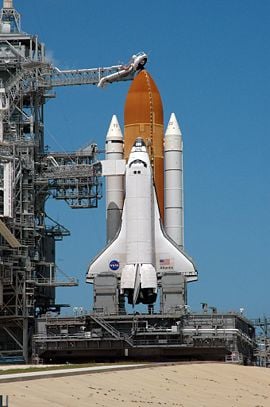 Space Shuttle Atlantis on the launch pad prior to the STS-115 mission. | |
| Fact canvass | |
|---|---|
| Function | Manned Re-usable Spaceplane |
| Manufacturer | United Space Alliance: Thiokol/Boeing (SRBs) Lockheed Martin (Martin Marietta) - (ET) Rockwell International (orbiter) |
| Country of origin | United States of America |
| Size | |
| Summit | 58.12 m (149.6 ft) |
| Bore | 8.vii m (28.v ft) |
| Mass | 2,029,203 kg (4,474,574 lb) |
| Stages | 2 |
| Chapters | |
| Payload to LEO | 24,400 kg (53,700 lb) |
| Payload to GTO | iii,810 kg (8,390 lb) |
| Launch History | |
| Status | Active |
| Launch sites | LC-39, Kennedy Space Center SLC-6, Vandenberg AFB (unused) |
| Total launches | 118 |
| Successes | 116 |
| Failures | two |
| Maiden flight | April 12 1981 |
| Notable payloads | International Infinite Station components Hubble Space Telescope Galileo Magellan Chandra Ten-ray Observatory |
| Boosters (Stage 0) - Solid Rocket Boosters | |
| Northo boosters | 2 |
| Engines | 1 solid |
| Thrust | 12,455 kN (approx. ii,800,000 lbf each, ocean level liftoff) |
| Specific impulse | 269 south |
| Burn fourth dimension | 124 southward |
| Fuel | solid |
| First Stage - External Tank | |
| Engines | (none) (three SSMEs located on Orbiter) |
| Thrust | 5,253 kN (ane,180,000 lbf combined full, sea level liftoff) |
| Specific impulse | 455 s |
| Burn time | 480 s |
| Fuel | LOX/LH2 |
| Second Stage - Orbiter | |
| Engines | 2 OME |
| Thrust | 53.378 kN (12,000 lbf combined total vacuum thrust) |
| Specific impulse | 316 due south |
| Burn time | 1250 s |
| Fuel | GN2 |
NASA's Space Shuttle, officially called the Space Transportation Arrangement (STS), was the United States government's manned launch vehicle from 1981 to 2011. At launch, it consisted of three main assemblies: a reusable Orbiter Vehicle (OV); a large, expendable External Tank (ET); and two relatively slender, partially reusable Solid Rocket Boosters (SRBs). Technically, this unabridged combination of assemblies is called the "Space Shuttle" (or the "Stack"), although at times the Orbiter alone is referred to equally the Space Shuttle.
The Shuttle was the starting time orbital spacecraft designed for partial reusability. The tank and boosters were jettisoned during ascent; simply the Orbiter went into infinite. The vehicle was launched vertically like a conventional rocket, and the orbiter glided to a horizontal landing, after which it could be refurbished for reuse.
The Orbiter carried astronauts and payloads such as satellites or space station parts into low world orbit. It provided crew rotation for the International Space Station (ISS) and performed servicing missions. It was used to return large payloads from the ISS to Globe, as the Russian Soyuz spacecraft has limited capacity for such return payloads. Each Shuttle was designed for a projected lifespan of 100 launches, or 10 years, operational life.
Contents
- 1 Clarification of main components
- 1.one Orbiter Vehicle
- 1.2 External tank
- 1.three Solid Rocket Boosters
- 1.4 Flight systems
- 1.5 Upgrades
- ii Launch
- iii Reentry and landing
- 3.1 Boosted landing sites
- 4 Technical information
- 5 Fleet history
- half dozen Retirement
- 6.i Distribution of orbiters
- vii Notes
- viii References
- 9 External links
- ten Credits
The Space Shuttle was retired from service upon the decision of the final flying of Atlantis on July 21, 2011.
Clarification of main components
Each Space Shuttle consisted of three principal parts: The Orbiter Vehicle, the External Tank, and the ii Solid Rocket Boosters (SRBs). The main person responsible for blueprint of the STS was Maxime Faget, who had previously overseen designs of the Mercury, Gemini, and Apollo spacecraft.
Orbiter Vehicle
Commonly, five to seven astronauts would ride in the Orbiter, although eight have been carried and eleven could be accommodated in an emergency landing. When the Orbiter's mission is completed, the crew fires its maneuvering thrusters to driblet out of orbit and re-enter the Earth's atmosphere. During its descent and landing, the Orbiter acts equally a glider and makes a completely unpowered ("expressionless stick") landing. Five spaceworthy Orbiters have been built, of which 3 remain.
The Orbiter resembles an aircraft with double-delta wings, swept 81° at the inner leading edge and 45° at the outer leading edge. Its vertical stabilizer'south leading edge is swept back at a 50° angle. The iv elevons, mounted at the trailing border of the wings, and the rudder/speed restriction, attached at the abaft edge of the stabilizer, with the body flap, control the Orbiter during descent and landing.
The Orbiter has a large, 60 by 15 ft (18 m by 4.vi m) payload bay, comprising most of the fuselage. The payload capacity is 50,000 pounds (lb) (22,700 kilograms). Three Space Shuttle Main Engines (SSMEs) are mounted on the Orbiter'southward aft fuselage in a triangular pattern. The three engines can swivel x.v degrees up and down and 8.five degrees from side to side during ascent to change the management of their thrust and steer the Shuttle equally well as push. The orbiter structure is made primarily from aluminum blend, although the engine thrust structure is made from titanium alloy.
The crucial factors in the size and shape of the Orbiter were the requirements that information technology be able to accommodate the largest planned spy satellites and take the cross-range recovery range to run into classified U.South. Air Forcefulness missions. Factors involved in opting for "reusable" solid rockets and an expendable fuel tank included the desire of the Pentagon to obtain a high-capacity payload vehicle for satellite deployment, and the desire of the Nixon administration to reduce the costs of infinite exploration by developing a spacecraft with reusable components.
The outset orbiter, Enterprise, was not built for actual space flying but was used only for testing purposes. Enterprise was followed by iv operational space shuttles: Columbia, Challenger, Discovery, and Atlantis. Challenger was destroyed on launch in 1986, and Endeavor was built as a replacement. Columbia was destroyed on re-entry in 2003.
External tank
The External Tank (ET) provides approximately 535,000 U.S. gallons (2.025 meg liters) of liquid hydrogen and liquid oxygen propellant to the SSMEs. Information technology is discarded 8.five minutes after launch at an distance of 60 nautical miles (111 km), and then burns up on re-entry. The ET is constructed mostly of ⅛ inch thick aluminum-lithium alloy.
The external tanks of the first 2 missions were painted white, which added an extra 600 pounds (270 kg) of weight to each ET. Subsequent missions have had unpainted tanks showing the natural orange-dark-brown colour of the spray-on cream insulation. The orange-brown color results from ultraviolet lite from the Sun hit the foam insulation over fourth dimension.[1]
Solid Rocket Boosters
Two Solid Rocket Boosters (SRBs) each provide 2.8 million lbs of thrust at liftoff, which is 83 percent of the full thrust needed for liftoff. They are jettisoned two minutes later launch at a height of about 150,000 feet (45.7 km), so deploy parachutes and country in the ocean to be recovered. The SRB cases are fabricated of steel nearly ½ inch (one.27 cm) thick.
Flight systems
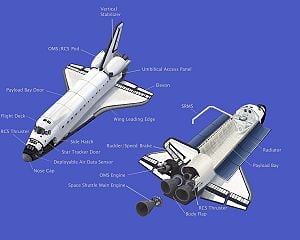
Structural overview of the Space Shuttle.
Early on Shuttle missions took along the Grid Compass, arguably 1 of the first laptop computers. The Compass sold poorly, because it cost at least $6000, merely offered unmatched performance for its weight and size.[ii] NASA was i of its principal customers.
The Shuttle was ane of the earliest arts and crafts to use a computerized fly-by-wire digital flight control system. This means no mechanical or hydraulic linkages connect the pilot's command stick to the control surfaces or reaction command system thrusters.
A chief business organisation with digital fly-by-wire systems is reliability. Much enquiry went into the Shuttle computer system. The Shuttle uses 5 identical redundant IBM 32-bit full general purpose computers (GPCs), model AP-101, constituting a type of embedded arrangement. Iv computers run specialized software called the Principal Avionics Software System (Pass). A fifth backup computer runs split software called the Backup Flight Arrangement (BFS). Collectively, they are called the Data Processing Organisation (DPS).[3]
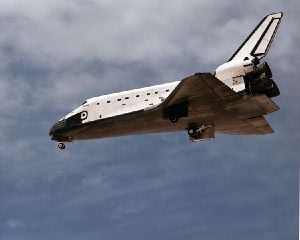
Atlantis deploys its landing gear before landing on a selected rails, in a manner similar to a mutual aircraft landing.
The design goal of the Shuttle'due south DPS is neglect operational/fail safe reliability. After a single failure the Shuttle can continue the mission. Afterwards 2 failures it can land safely.
The four general-purpose computers operate essentially in lockstep, checking each other. If ane computer fails, the three functioning computers "vote" it out of the system. This isolates information technology from vehicle control. If a second computer of the three remaining fails, the two functioning computers vote it out. In the rare case of 2 out of four computers simultaneously failing (a two-two divide), 1 group is picked at random.
The Backup Flight Arrangement (BFS) is separately developed software running on the fifth computer, used only if the entire four-computer primary system fails. The BFS was created because although the four primary computers are hardware redundant, they all run the aforementioned software, so a generic software trouble could crash all of them. Embedded system avionic software is developed under totally different atmospheric condition from public commercial software, the number of code lines is tiny compared to a public commercial software, changes are only fabricated infrequently and with extensive testing, and many programming and exam personnel piece of work on the modest amount of estimator code. Still, in theory it tin all the same fail, and the BFS exists for that contingency.
The software for the Shuttle computers is written in a high-level language called HAL/S, somewhat similar to PL/I. It is specifically designed for a real time embedded system environment.
The IBM AP-101 computers originally had about 424 kilobytes of magnetic core memory each. The CPU could process about 400,000 instructions per second. They have no hd and load software from magnetic tape cartridges.
In 1990, the original computers were replaced with an upgraded model AP-101S, which has almost 2.5 times the memory capacity (about 1 megabyte) and three times the processor speed (about i.2 million instructions per second). The memory was changed from magnetic core to semiconductor with battery backup.
Upgrades
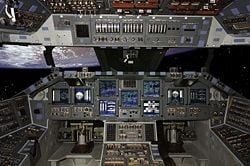
During STS-101, Atlantis was the first Shuttle to fly with a glass cockpit.
Internally, the Shuttle remained largely similar to the original design, with the exception of the improved avionics computers. In addition to the computer upgrades, the original vector graphics monochrome cockpit displays were replaced with modern full-color, flat-console brandish screens, similar to contemporary airliners similar the Boeing 777. This is called a "glass cockpit." In the Apollo-Soyuz Test Project tradition, programmable calculators are carried every bit well (originally the HP-41C). With the coming of the ISS, the Orbiter's internal airlocks accept been replaced with external docking systems to allow for a greater amount of cargo to be stored on the Shuttle'southward mid-deck during Station resupply missions.
The Space Shuttle Main Engines have had several improvements to enhance reliability and power. This explains phrases such as "Chief engines throttling upwardly to 104 percent." This does not mean the engines are being run over a safe limit. The 100 percentage figure is the original specified power level. During the lengthy development plan, Rocketdyne determined the engine was capable of condom reliable operation at 104 pct of the originally specified thrust. They could have rescaled the output number, saying in essence 104 percent is now 100 percent. However, this would accept required revising much previous documentation and software, so the 104 percent number was retained. SSME upgrades are denoted as "block numbers," such as block I, block Ii, and block IIA. The upgrades have improved engine reliability, maintainability and functioning. The 109 percent thrust level was finally reached in flight hardware with the Cake II engines in 2001. The normal maximum throttle is 104 percent, with 106 percentage and 109 percent bachelor for arrest emergencies.
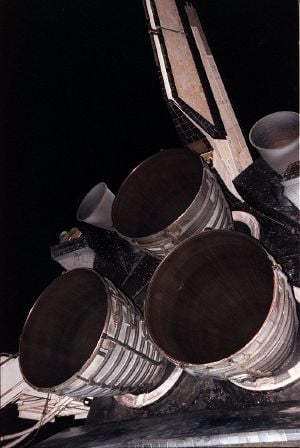
The iii nozzles of the Main Engine cluster with the two OMS pods and the vertical stabilizer to a higher place.
For the first two missions, STS-ane and STS-2, the external tank was painted white to protect the insulation that covers much of the tank, just improvements and testing showed that it was not required. The weight saved by non painting the tank results in an increase in payload adequacy to orbit. Additional weight was saved by removing some of the internal "stringers" in the hydrogen tank that proved unnecessary. The resulting "light-weight external tank" has been used on the vast majority of Shuttle missions. STS-91 saw the start flying of the "super light-weight external tank." This version of the tank is made of the 2195 aluminium-lithium blend. It weighs 7,500 lb (3.four t) less than the last run of lightweight tanks. As the Shuttle cannot wing unmanned, each of these improvements has been "tested" on operational flights.
The SRBs (Solid Rocket Boosters) have undergone improvements as well. Notable is the adding of a 3rd O-ring seal to the joints between the segments, which occurred later on the Challenger disaster.
Several other SRB improvements were planned in social club to better operation and rubber, but never came to be. These culminated in the considerably simpler, lower toll, probably safer, and improve performing Advanced Solid Rocket Booster which was to have entered production in the early on to mid-1990s to support the Space Station, simply was later canceled to save money afterward the expenditure of $2.two billion. The loss of the ASRB program forced the development of the Super Light Weight external Tank (SLWT), which provides some of the increased payload capability, while not providing any of the safety improvements. In addition, the Air Force adult their own much lighter single-piece SRB blueprint using a filament-wound system, but this too was canceled.
STS-seventy was delayed in 1995, when woodpeckers bored holes in the cream insulation of Discovery's external tank. Since then, NASA has installed commercial plastic owl decoys and inflatable owl balloons which must be removed prior to launch.[4] The delicate nature of the foam insulation has been the cause of damage to the tile oestrus shield and heat wrap of the shuttle during contempo launches. NASA remains confident that this impairment, while linked to the Columbia space shuttle disaster on February i, 2003, will non jeopardize the objective of NASA to consummate the International Space Station (ISS) in the projected time allotted.
A cargo-only, unmanned variant of the Shuttle has been variously proposed and rejected since the 1980s. Information technology is chosen the Shuttle-C and would trade re-usability for cargo capability with large potential savings from reusing applied science developed for the Infinite Shuttle.
On the showtime four Shuttle missions, astronauts wore modified U.Due south. Air Force high-distance full-pressure suits, which included a full-pressure helmet during ascent and descent. From the 5th flight, STS-5, until the loss of Challenger, one-piece light blue nomex flight suits and partial-pressure helmets were worn. A less-beefy, fractional-pressure level version of the loftier-distance pressure level suits with a helmet was reinstated when Shuttle flights resumed in 1988. The LES concluded its service life in tardily 1995, and was replaced past the full-pressure Avant-garde Crew Escape Suit (ACES), which resembles the Gemini space conform worn in the mid-1960s.
To extend the duration that Orbiter tin stay docked at the ISS, the Station-Shuttle Ability Transfer System (SSPTS) was installed. This modification allows Orbiter to use power provided past the ISS and to preserve its consumables onboard.
Launch
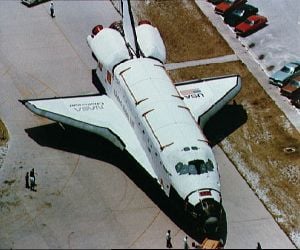
Infinite Shuttle Challenger's rollout from Orbiter Processing Facility (OPF) to the Vehicle Associates Building (VAB) to be stacked with External tank and SRB's for launch. (NASA photo).
The launching of a shuttle required not but technical and personnel readiness but also appropriate weather condition weather. For instance, the shuttle would not be launched under conditions in which it could be struck by lightning. Shipping are often struck by lightning with no adverse furnishings because the electricity of the strike is dissipated through its conductive structure and the aircraft is not electrically grounded. Like most jet airliners, the shuttle is constructed mainly of conductive aluminum, which unremarkably protects the internal systems. Withal, at takeoff, the shuttle sends out a long exhaust plume as it ascends, and this plumage can trigger lightning past providing a current path to ground. Although the shuttle might safely endure a lightning strike, a like strike caused problems on Apollo 12, so for safety, NASA chooses not to launch the shuttle if lightning is possible.
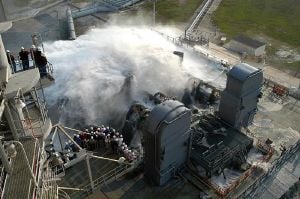
Water is released onto the mobile launcher platform on Launch Pad 39A at the start of a rare sound suppression arrangement test in 2004. During launch, 300,000 gallons are poured onto the pad in only 20 seconds.
On the day of a launch, later on the final concur in the inaugural at T minus 9 minutes, the Shuttle goes through its final preparations for launch, and the countdown is automatically controlled by a special computer program at the Launch Command Center known every bit the Ground Launch Sequencer (GLS), which stops the count if it senses a critical problem with whatever of the Shuttle'southward on-board systems. The GLS easily off the count to the Shuttle'due south on-board computers at T minus 31 seconds.
At T-minus 10 seconds, hydrogen igniters are activated under each engine bell to quell the stagnant gas inside the cones before ignition. Failure to burn these gases tin trip the onboard sensors and create the possibility of an overpressure and explosion of the vehicle during the firing phase. The main engine turbopumps are besides commanded to begin charging the combustion chambers with liquid hydrogen and liquid oxygen at this time. The computers reciprocate this activity by allowing the redundant computer systems to begin the firing phase.
The 3 Space Shuttle Principal Engines (SSMEs) beginning at T minus half dozen.6 seconds. The main engines ignite sequentially via the shuttle'southward general purpose computers (GPC's) at 0.12 2nd intervals. The GPC'due south require that the engines reach 90 per centum of their rated performance to complete the terminal gimbal of the main engine nozzles to liftoff configuration.[5] When the SSMEs first, the h2o from the audio suppression system flashes into a large book of steam that shoots southward.

Shuttle launch of Atlantis at sunset in 2001. The dominicus is behind the camera, and the feather'due south shadow intersects the moon across the sky.
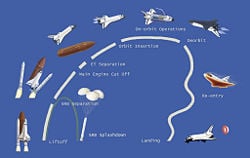
All iii SSMEs must reach the required 100 percent thrust within iii seconds to initiate the SRB firing command. If the onboard computers verify normal thrust buildup, at T minus 0 seconds, the SRBs are ignited. At this point the vehicle is committed to takeoff, equally the SRBs cannot be turned off once ignited. After the SRBs accomplish a stable thrust ratio, pyrotechnic nuts are detonated by radio controlled signals from the shuttle's GPC'due south to release the vehicle.[6] The plumage from the solid rockets exits the flame trench at near the speed of sound, oftentimes causing a rippling of shockwaves forth the actual flame and smoke contrails. At ignition, the GPC's mandate the firing sequences via the "Master Events Controller," a computer programme integrated with the shuttle'south four redundant reckoner systems.
At that place are all-encompassing emergency procedures (arrest modes) to handle various failure scenarios during ascent. Many of these concern SSME failures, since that is the most complex and highly stressed component. Afterward the Challenger disaster, there were extensive upgrades to the abort modes.
When watching a launch, await for the "nod" ("twang" in NASA lingo). Afterwards the primary engines beginning, but while the solid rocket boosters are still clamped to the pad, the offset thrust from the Shuttle's three primary engines causes the entire launch stack (boosters, tank and shuttle) to flex forward, about ii m at cockpit level. As the boosters flex back to their original position, the launch stack springs slowly dorsum upright. This takes approximately 6 seconds. When it is perfectly vertical, the boosters ignite and the launch commences.
Before long afterwards clearing the belfry, the Shuttle begins a "roll-and-pitch" program to set its orbital inclination, and so that the vehicle is below the external tank and SRBs, with wings level. The vehicle climbs in a progressively flattening arc, accelerating as the weight of the SRBs and primary tank subtract. To attain low orbit requires much more horizontal than vertical acceleration. This is not visually obvious since the vehicle rises vertically and is out of sight for nigh of the horizontal acceleration. The near circular orbital velocity at the 380 km (236 miles) altitude of the International Infinite Station is vii.68 km per second (27,648 km/h, 17,180 mph), roughly equivalent to Mach 23 at sea level. For missions towards the International Space Station, the shuttle must reach an azimuth of 51.6 degrees inclination to rendezvous with the station.
Effectually a signal chosen "Max Q," where the aerodynamic forces are at their maximum, the main engines are temporarily throttled dorsum to avert overspeeding and hence overstressing the Shuttle, particularly in vulnerable areas such as the wings. At this point, a phenomenon known as the "Prandtl-Glauert Singularity" occurs, where condensation clouds course during the vehicle's transition to supersonic speed.
At 126 seconds after launch, explosive bolts release the SRBs and small-scale separation rockets push button them laterally away from the vehicle. The SRBs parachute back to the ocean to be reused. The Shuttle then begins accelerating to orbit on the Infinite Shuttle chief engines. The vehicle at that point in the flying has a thrust to weight ratio of less than one—the principal engines actually have insufficient thrust to exceed the forcefulness of gravity, and the vertical speed given to it past the SRBs temporarily decreases. However, as the burn continues, the weight of the propellant decreases and the thrust-to-weight ratio exceeds 1 over again and the ever-lighter vehicle and so continues to accelerate toward orbit.
The vehicle continues to climb and takes on a somewhat nose-up angle to the horizon—it uses the main engines to gain and and then maintains altitude while it accelerates horizontally towards orbit. At almost five and three-quarter minutes into ascent, the orbiter rolls heads up to switch advice links from ground stations to Tracking and Information Relay Satellites.
Finally, in the last tens of seconds of the principal engine burn, the mass of the vehicle is low plenty that the engines must exist throttled dorsum to limit vehicle acceleration to 3 g, largely for astronaut comfort.
Earlier complete depletion of propellant, equally running dry would destroy the engines, the main engines are shut down. The oxygen supply is terminated before the hydrogen supply, equally the SSMEs react unfavorably to other shutdown modes. Liquid oxygen has a tendency to react violently, and supports combustion when it encounters hot engine metal. The external tank is released past firing explosive bolts and falls, largely called-for up in the temper, though some fragments fall into the Indian Bounding main. The sealing action of the tank plumbing and lack of pressure relief systems on the external tank helps information technology "break upwards" in the atmosphere. Later on the foam burns away during reentry, the estrus causes a pressure level build-up in the remaining liquid oxygen and hydrogen until the tank explodes. This ensures that any pieces that fall back to Earth are pocket-size.
To prevent the shuttle from following the external tank back into the atmosphere, the OMS engines are fired to heighten the perigee out of the atmosphere. On some missions (such every bit STS-107 and missions to the ISS), the OMS engines are also used while the main engines are still firing. The reason for putting the orbiter on a path that brings it back to Earth is not just for external tank disposal. Information technology is one of safety; if the OMS malfunctions, or the cargo bay doors cannot open for some reason, the shuttle is already on a path to return to World for an emergency abort landing.
Reentry and landing
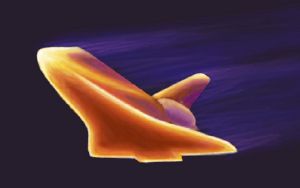
A estimator simulation of the outside of the Shuttle every bit it heats upwardly to over 1,500 °C during re-entry.
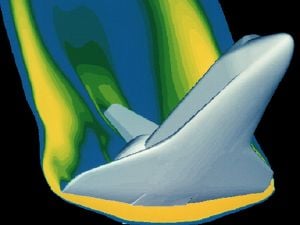
A computer simulation of high velocity air menstruation around the Infinite Shuttle during re-entry.
Virtually the entire Infinite Shuttle reentry, except for lowering the landing gear and deploying the air data probes, is normally performed under computer control. Nonetheless, the reentry can be and has (once) been flown entirely manually. The approach and landing phase can be controlled by the autopilot, simply is commonly hand flown.
The vehicle begins reentry by firing the OMS engines, while flying upside down backside offset, in the opposite management to orbital motion for about three minutes giving roughly 200 mph of delta-five. The resultant slowing of the Shuttle lowers its orbital perigee down into the atmosphere. The shuttle flips over by pulling its nose up (which is really "downwardly" because information technology'southward flight upside down). This OMS firing is washed roughly halfway around the globe from the landing site.
The vehicle starts significantly entering the temper at near 400,000 ft (120 km) at around Mach 25 (8.2 km/due south). The vehicle is controlled by a combination of RCS thrusters and control surfaces, to wing at a twoscore degree nose-up mental attitude producing high drag, non only to dull it down to landing speed, but also to reduce reentry heating. In addition, the vehicle needs to drain off extra speed earlier reaching the landing site. This is accomplished past performing south-curves at up to a 70 degree roll angle.
In the lower temper, the Orbiter flies much like a conventional glider, except for a much higher descent rate, over x,000 anxiety (iii km) per minute. At approximately Mach 3, 2 air data probes, located on the left and right sides of the Orbiter's forrad lower fuselage, are deployed to sense air pressure related to vehicle'southward movement in the atmosphere.
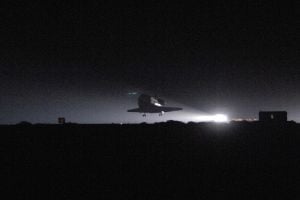
Discovery touches down at Edwards Air Strength Base at the end of STS-114.
When the arroyo and landing phase begins, the Orbiter is at a x,000-ft (3048 yard) altitude, seven.5 miles (12.1 km) from the track. The pilots apply aerodynamic braking to help irksome down the vehicle. The Orbiter's speed is reduced from 424 mph (682 km/h) to approximately 215 mph (346 km/h), (compared to 160 mph for a jet airliner), at touchdown. The landing gear is deployed while the Orbiter is flight at 267 mph (430 km/h). To assist the speed brakes, a twoscore ft (12.ii m) drag chute is deployed either afterwards primary gear or nose gear touchdown (depending on selected chute deploy mode) at virtually 213 mph (343 km/h). It is jettisoned as the Orbiter slows through 69 mph (111 km/h).
Afterward landing, the vehicle stands on the runway for several minutes to permit the fumes from poisonous hydrazine, used as a propellant for attitude control, to dissipate, and for the shuttle fuselage to cool before the astronauts disembark.
Weather permitting, the Space Shuttle will ever land at Kennedy Infinite Center. Withal, if the conditions make landing there unfavorable, the Shuttle tin touch down at Edwards Air Strength Base in California or at other sites around the globe. A landing at Edwards means that the shuttle must be mated to the Shuttle Carrier Aircraft and returned to Greatcoat Canaveral, costing NASA an boosted ane.7 meg dollars. A Space Shuttle (STS-3, Columbia) has also landed in one case at the White Sands Space Harbor in New Mexico, but this is oft a final resort, as NASA scientists believe that the sand could crusade damage to the shuttle'due south exterior.
Additional landing sites
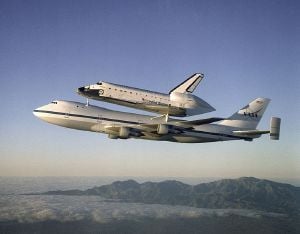
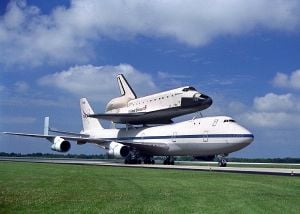
A list of additional landing sites is given below.
- White Sands Space Harbor, New Mexico
- MCAS Yuma/Yuma International Aerodrome, Arizona
- Plattsburgh Air Forcefulness Base, New York (Former site; now closed)
- Ben Guerir Air Base of operations, Morocco
- Morón Air Base of operations, Spain
- Banjul International Airport (Yundum), Republic of the gambia
- Zaragoza Air Base, Espana
- RAAF Base of operations Amberley, Commonwealth of australia
- Andersen AFB, Guam
- Amilcar Cabral International Airport, Cape verde
- Hickam AFB, Hawaii
- Stockholm-Arlanda Aerodrome, Sweden
- Shannon International Airport, Ireland
- Istres AB, France
- Bangor International Aerodrome, Maine
Potential launch arrest sites are as follows:
- Darwin, Commonwealth of australia
- Myrtle Embankment, South Carolina
- Dyess Air Force Base, Texas
- Marine Corps Air Station Ruby Bespeak, North Carolina
- Ellsworth Air Force Base, Due south Dakota
- Naval Air Station Oceana, Virginia Embankment, VA
- Esenboğa International Airport, Ankara, Turkey
- Dover Air Force Base, Delaware
- Fort Wayne International Airdrome (Air Baby-sit Station), Fort Wayne, IN
- Gran Canaria (Las Palmas), Canary Islands
- Otis Air National Guard Base, Massachusetts
- Grant County (Moses Lake), Washington
- Pease ANGB, New Hampshire
- Hao, French Polynesia
- AFB Hoedspruit, Southward Africa
- Bermuda International Airport (onetime NAS Bermuda)
- Rex Khalid International Aerodrome, Riyadh, Saudi Arabia
- Kinshasa, Democratic republic of the congo
- Cologne Bonn Airdrome, Federal republic of germany
- Lajes Field, Azores
- Lincoln Airport, Nebraska
- Mountain Home Air Strength Base, ID
- Nassau, Commonwealth of the bahamas
- NSA Souda Bay, Crete, Greece
- NSF Diego Garcia, Chagos Archipelago, Indian Ocean
- Orlando International Airport, Florida
- RAF Fairford, United kingdom of great britain and northern ireland
- Roberts International Aerodrome, Monrovia, Liberia
- Allentown,PA,Usa
- Mataveri International Airport, Easter Island, Chile
- Halifax International Airport, Halifax, Nova Scotia, Canada
Technical data
Orbiter Specifications (for Endeavor, OV-105):
- Length: 124.17 ft (37.24 m)
- Wingspan: 79.06 ft (23.79 g)
- Top: 58.58 ft (17.25 m)
- Empty Weight: 156,205 lb (69,586.6 kg)
- Gross Liftoff Weight: 240,000 lb (109,000 kg)
- Maximum Landing Weight: 230,000 lb (104,000 kg)
- Principal Engines: Three Rocketdyne Block two A SSMEs, each with a sea level thrust of 393,800 lbf (178,624 kgf / i.75 MN)
- Maximum Payload: 55,250 lb (25,061.4 kg)
- Payload Bay dimensions: xv ft by threescore ft (4.half dozen thou by 18.3 m)
- Operational Altitude: 100 to 520 nmi (185 to 1,000 km)
- Speed: 27,404 ft/s (7,643 m/southward, 27,875 km/h, 17,321 mi/h)
- Crossrange: 1,085 nautical miles (ii,009.iv km)
- Crew: Eight (Commander, Pilot, Co-pilot,two Mission Specialists, and 3 Payload Specialists), two for minimum.
External Tank Specifications (for SLWT)
- Length: 156.8 ft (48.9 chiliad)
- Diameter: 32.vi ft (10.four m)
- Propellant Book: 535,000 gallon (2,030,000 L)
- Empty Weight: 58,500 lb (26,559 kg)
- Gross Liftoff Weight: 1.667 million lb (757,000 kg)
Solid Rocket Booster Specifications
- Length: 149.6 ft (45.vi yard)
- Diameter: 12.17 ft (3.71 chiliad)
- Empty Weight (per booster): 139,490 lb (63,272.7 kg)
- Gross Liftoff Weight (per booster): 1.three million lb (590,000 kg)
- Thrust (sea level, liftoff): 2.viii million lbf (1,270,058 kgf / 12.46MN)
System Stack Specifications
- Acme: 184.ii ft (56.xiv m)
- Gross Liftoff Weight: four.five million lb (2.04 million kg)
- Total Liftoff Thrust: six.781 million lbf (iii.076 million kgf / 30.16MN)
Fleet history
Beneath is a listing of major events in the Space Shuttle orbiter fleet.
| Engagement | Orbiter | Major effect / remarks |
|---|---|---|
| September 17, 1976 | Enterprise | Prototype Space Shuttle Enterprise was rolled out of its assembly facility in Southern California and displayed before a crowd several thousand strong.[seven] |
| February 18, 1977 | Enterprise | Outset flight; Fastened to Shuttle Carrier Aircraft throughout flying. |
| Baronial 12, 1977 | Enterprise | First free flying; Tailcone on; lakebed landing. |
| October 26, 1977 | Enterprise | Final Enterprise free flight; Outset landing on Edwards AFB concrete rail. |
| April 12, 1981 | Columbia | Beginning Columbia flying, first orbital test flight; STS-1 |
| November 11, 1982 | Columbia | First operational flying of the Space Shuttle, first mission to carry four astronauts; STS-5 |
| April 4, 1983 | Challenger | Outset Challenger flight; STS-6 |
| August 30, 1984 | Discovery | Offset Discovery flight; STS-41-D |
| October three, 1985 | Atlantis | First Atlantis flight; STS-51-J |
| October 30, 1985 | Challenger | First crew of eight astronauts; STS-61-A |
| January 28, 1986 | Challenger | Disaster starting 73 seconds subsequently launch; STS-51-Fifty; all seven coiffure members died. |
| September 29, 1988 | Discovery | First post-Challenger mission; STS-26 |
| May 4, 1989 | Atlantis | The start Space Shuttle mission to launch an interplanetary probe, Magellan; STS-30 |
| April 24, 1990 | Discovery | Launch of the Hubble Space Telescope; STS-31 |
| May vii, 1992 | Try | Starting time Endeavour flight; STS-49 |
| November nineteen, 1996 | Columbia | Longest Shuttle mission at 17 days, 15 hours; STS-eighty |
| Dec 4, 1998 | Endeavor | Commencement ISS mission; STS-88 |
| February 1, 2003 | Columbia | Disintegrated during re-entry; STS-107; all seven coiffure members died. |
| July 25, 2005 | Discovery | First postal service-Columbia mission; STS-114 |
| February 24, 2011 | Discovery | Terminal Discovery flight; STS-133 |
| May xvi, 2011 | Attempt | Final Try mission; STS-134[8] |
| July 8, 2011 | Atlantis | Last Atlantis flight and terminal Space Shuttle flight; STS-135 |
Sources: NASA launch manifest,[9] NASA Infinite Shuttle annal[10]
Retirement
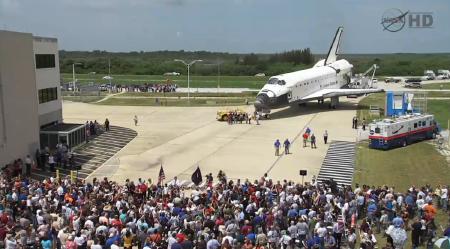
Atlantis orbiter'south last welcome domicile, 2011.
NASA retired the Infinite Shuttle in 2011, subsequently thirty years of service. The Shuttle was originally conceived of and presented to the public as a "Space Truck", which would, among other things, be used to build a U.s. space station in low earth orbit in the early 1990s. When the U.s. infinite station evolved into the International Space Station project, which suffered from long delays and design changes before it could be completed, the service life of the Infinite Shuttle was extended several times until 2011, serving at to the lowest degree 15 years longer than it was originally designed to exercise. Discovery was the first of NASA'southward iii remaining operational Space Shuttles to be retired.[11]
The final Space Shuttle mission was originally scheduled for late 2010, simply the plan was afterwards extended to July 2011 when Michael Suffredini of the ISS program said that one additional trip was needed in 2011 to evangelize parts to the International Space Station.[12] The Shuttle's terminal mission consisted of simply iv astronauts—Christopher Ferguson (Commander), Douglas Hurley (Airplane pilot), Sandra Magnus (Mission Specialist 1), and Rex Walheim (Mission Specialist 2);[13] they conducted the 135th and last space Shuttle mission on lath Atlantis, which launched on July 8, 2011, and landed safely at the Kennedy Space Center on July 21, 2011, at v:57 AM EDT (09:57 UTC).[14]
Distribution of orbiters
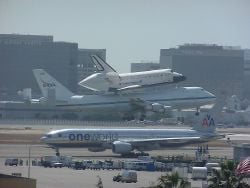
Effort at Los Angeles International Airdrome
Locations for the remaining Shuttle orbiters are as follows:
- Atlantis is on brandish at the Kennedy Space Center Visitor Complex, almost Greatcoat Canaveral, Florida. It was delivered to the Visitor Circuitous on November 2, 2012.
- Discovery was delivered to the Udvar-Hazy Eye of the Smithsonian Institution's National Air and Space Museum in Chantilly, Virginia, nigh Washington, D.C. on Apr nineteen, 2012. On April 17, 2012, Discovery was flown atop a 747 Shuttle Carrier Aircraft escorted past a NASA T-38 Talon chase shipping in a last farewell flying. The 747 and Discovery flew over Washington, D.C. and the metropolitan area effectually 10 am and arrived at Dulles around eleven am. The flyover and landing were widely covered on national news media.
- Endeavour was delivered to the California Science Center in Los Angeles, California on October xiv, 2012. It arrived at Los Angeles International Airport on September 21, 2012, concluding a two-day, cross country journey atop the Shuttle Carrier Aircraft after stops at Ellington Field in Houston, Biggs Regular army Airfield in El Paso and the Dryden Flying Enquiry Facility at Edwards Air Forcefulness Base, California.
- Enterprise (atmospheric exam orbiter) was on brandish at the National Air and Space Museum's Udvar-Hazy Eye but was moved to New York Metropolis's Intrepid Sea-Air-Space Museum in mid-2012.
Notes
- ↑ Irene Klotz, NASA shuttle tank an eyesore merely ready to wing. Retrieved Baronial 10, 2007.
- ↑ pages.total.internet, GRiD Compass 1101. Retrieved August 10, 2007.
- ↑ Roscoe C. Ferguson, Robert Tate, and Hiram C. Thompson, Implementing Space Shuttle Information Processing Organisation Concepts in Programmable Logic Devices. Retrieved August 10, 2007.
- ↑ Jim Dumoulin, Woodpeckers damage STS-70 External Tank. Retrieved August x, 2007.
- ↑ NASA, NASA—Countdown 101. Retrieved August 10, 2007.
- ↑ NASA, Hold-Downwardly Posts. Retrieved Nov 22, 2007.
- ↑ Mike Wall, 35 Years Ago: NASA Unveils Get-go Infinite Shuttle, 'Enterprise' Yahoo! News, September 17, 2011. Retrieved October 13, 2015.
- ↑ NASA Updates Shuttle Target Launch Dates For Terminal Ii Flights NASA. Retrieved Oct 13, 2015.
- ↑ Consolidated Launch Manifest NASA. Retrieved October 13, 2015.
- ↑ Space Shuttle Mission Athenaeum NASA. Retrieved October 13, 2015.
- ↑ NASA's Shuttle and Rocket Launch Schedule NASA. Retrieved October 13, 2015.
- ↑ John Pike, Space Shuttle may go on through next year – Roscosmos Globalsecurity.org, May 13, 2010. Retrieved October 13, 2015.
- ↑ "Rare Iv-Member Crew to Fly Final Shuttle". FoxNews.com, July 3, 2011. Retrieved Oct xiii, 2015.
- ↑ Launch and Landing NASA. Retrieved Oct thirteen, 2015.
References
ISBN links support NWE through referral fees
- Harland, David M. 2004. The Story of the Space Shuttle. London: Springer. ISBN 1852337931
- Harrington, Philip Due south., and Roger Ressmeyer. 2003. The Space Shuttle: A Photographic History. San Francisco: Browntrout Publishers. ISBN 0763170631
- Jenkins, Dennis R. 2001. Space Shuttle: The History of the National Space Transportation System: The First 100 Missions. Cape Canaveral, FL: D.R. Jenkins. ISBN 0963397451
- Joëls, Kerry Marker, Gregory P. Kennedy, and David Larkin. 1988. The Space Shuttle Operator'southward Manual. New York: Ballantine Books. ISBN 0345341813
External links
All links retrieved December x, 2019.
- Reference manual.
- How Infinite Shuttles Piece of work.
- NASA Space Shuttle News Reference - 1981 (PDF document).
- Orbiter Vehicles.
- Lecture Serial on the Space Shuttle from MIT OpenCourseWare.
- NASA Human Spaceflight - Space Shuttle
- Space Shuttle Emergency Landing Sites.
- NASA Shuttle Gallery.
| Infinite Shuttles | |||
|---|---|---|---|
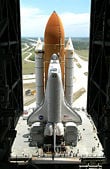 |
|
| |
Credits
New World Encyclopedia writers and editors rewrote and completed the Wikipedia article in accordance with New Globe Encyclopedia standards. This commodity abides by terms of the Creative Commons CC-by-sa 3.0 License (CC-by-sa), which may exist used and disseminated with proper attribution. Credit is due nether the terms of this license that can reference both the New World Encyclopedia contributors and the selfless volunteer contributors of the Wikimedia Foundation. To cite this article click here for a list of adequate citing formats.The history of earlier contributions past wikipedians is accessible to researchers here:
- Space Shuttle history
The history of this commodity since it was imported to New World Encyclopedia:
- History of "Space Shuttle"
Annotation: Some restrictions may apply to use of private images which are separately licensed.
Weight Of A Space Shuttle,
Source: https://www.newworldencyclopedia.org/entry/Space_shuttle
Posted by: morelandshrem1977.blogspot.com


0 Response to "Weight Of A Space Shuttle"
Post a Comment